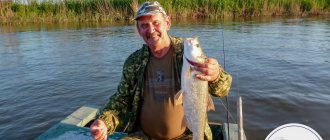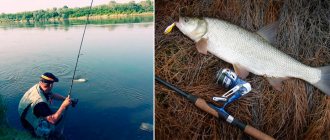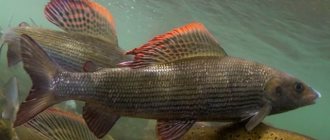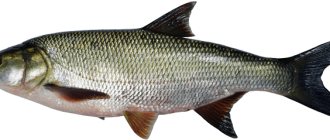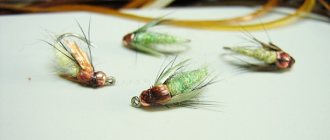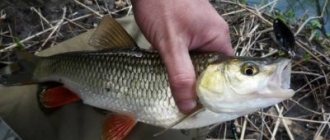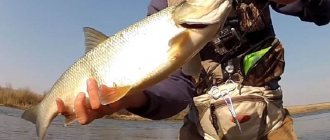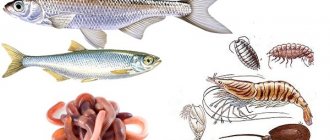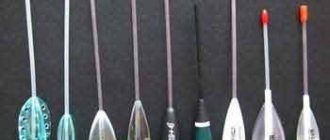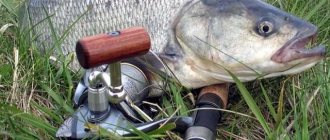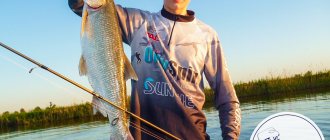The asp is a prime example of a cautious predator. It has an elongated body. The average length is 50 cm. Although it does not have such sharp teeth as a pike, it will not miss its prey. Lives exclusively in fresh water bodies with currents.
Every fisherman wants to add such a trophy to his victories, but not everyone succeeds. Hunting for such representatives of the fish family requires careful preparation, the right location, and equipment.
Catching asp using a bombard is considered the most effective. What are its advantages, installation features, and components, we will explain further.
What it is
Often it is a plastic tube through which the fishing line is pulled. One of the ends is thickened and shaped like an oblong ball or drop.
The main function of a bombard is to cast any bait, even a small one, over long distances.
That is why fishermen classify bombarda as a type of float and often call it sbirulino.
It is divided into two types:
- floating,
- drowning
When giving preference to a purchased option, it is recommended to check the reliability of the antenna mounting and the quality of the material from which it is made. There should be no cracks or scratches on the surface.
Advantages of choice
Among the advantages of use it is worth highlighting:
- Range. The asp is very careful and will not swim close to the boat or shore.
- Large selection of predatory trophies.
- Easy installation of equipment.
- Affordable price.
In order not to waste time, you can change the fishing technique, fishing tactics, and while waiting for the asp, replenish your catch with other predators.
Unlike classic spinning fishing, using a bombard for asp increases the fishing chances of catching a standing predator significantly. Because sbirulino is always interesting not only for asp, but also for pike, chub, elm, and perch.
Lures for fishing with bombard
Properly selected bait ensures a good catch of this cunning and cautious predator. To catch it, natural and artificial baits are used. As artificial baits for sherespers, they mainly use foam balls with flavors, small wobblers, silicone fish, and artificial flies. Each angler chooses bait at his own discretion.
Natural baits include: worms, flies, maggots, grasshoppers, leeches and small fish.
What parts does it consist of?
Let's look at the main components in more detail.
The photo shows an example of equipment with a bombard, the placement of each element is indicated.
Rod
The optimal option is light, flexible tackle 3 m long. In conditions with limited financial resources, at first you can get by with a Bolognese or match rod or feeder.
A correctly selected fishing rod is a guarantee of high-quality and accurate casting to the right place in the reservoir.
Among the best models that are on sale today, it is worth highlighting:
- Shimano Katana 330 BX M 10–30g,
- Mikado T-Rex 232/305 cm up to 55g,
- Shimano Hyperloop 330 AX H 20-50g.
It is possible to use rods of greater length, but they will be inconvenient when casting. And their dimensions when folded are quite large.
Coil
The recommended reel size is from 2500. Smaller dimensions will also reduce the casting distance of the rod.
When hunting for predatory fish, the strength of the reel is no less important. It would be better if it had a solid metal body and additionally contained 2 spare spools.
According to reviews from experienced fishermen, the Ryobi Zauber brand performs well with models of 3000 and 4000.
Fishing line, cord
If you are used to using a cord, then it is important to remember that its thickness directly depends on the weight of the bombard.
As the main fishing line, it is better to buy braided line from 130 to 200 m unwound.
So, for 30 g of sbirulino you need to use a cord with a diameter of 0.16 mm or even more.
Products from the Konger and Kamatsu Techron brands are considered reliable.
The leash should be based on a monofilament line with a diameter of 0.25 - 0.3 mm.
The recommended leash length when catching asp with a bombard rod over 3 m is from 1.5 m. For a spinning rod of 3 m, a meter leash is enough.
Suitable types of bait
In addition, the bait should be at least 15–20 times lighter than the bombard. Otherwise, there can be no question of casting range. Plus, frequent overlaps are possible.
In search of the ideal bait, you need to remember one important rule: the asp is a surface predator, which means the bait should go close to the surface of the water.
If we talk about wobblers, then this is not the best choice. Over long distances, due to the side “wings” they will fly poorly behind the sbirulino. It is not advisable to use spinners because they spin the leash.
According to most fishermen, a light turbine is a suitable option. The bait is universal. It is distinguished by stable play in the entire direction of wiring. Average weight - 1.5 g. In appearance it resembles Aglia Mepps zero.
It is recommended to catch asp using the following types of bait:
- jigs, streamers imitating insects,
- crank frogs,
- jigs,
- front sight,
- fry
Important points regarding fishing
If a fisherman decides to use a spinning rod, then he must make long and accurate casts. In this case, everything depends on the person’s ability to “throw” the bait to the required distance.
It is not uncommon for asps to react to splashes of water. Therefore, in order to prevent this, you should hold the line with your finger while casting. This way you can avoid catching the float with a hook, and also start quickly wiring.
When the asp is hooked, they begin to actively pull it towards the shore, and 15 meters from the shore, the speed at which the reel rotates must be increased. Resistance can be broken by allowing the specimen to take a breath of air. That is why the asp needs to be pulled out into shallow water as quickly as possible.
Where to look for asp
The predator's spawning begins in the second half of April. At this time, he tries to choose areas of the reservoir with increased current. But by the beginning of June, the fish begins to look for secluded places where it is better to hide.
The asp is a lover of running water, so a large number of individuals of this species are found in rivers with a wide channel (over 100 m).
These include:
- small islands,
- fallen old trees, snags,
- rifts,
- boulders,
- ditches,
- pits,
- areas below the dams, under the bridge.
In addition, when using a bombard for asp, two principles of fishing should be taken into account:
- at the location of the water splash,
- in the most likely places for individuals to stay.
The predator is most active in the summer at early dawn and before 9 a.m. and after sunset. In spring and autumn its activity decreases. If he becomes interested in the bait, it will most likely be in the afternoon.
Experienced fishermen advise, upon arriving at a pond, to immediately visually identify its possible habitats and begin fishing for them. If there is no result, do not waste time and look for other suitable areas of the reservoir.
Habitats and behavior of the asp
The habitat of the asp is quite large; it can be found in almost all rivers flowing into the Black, Azov, Baltic and Caspian seas. It also lives in Ilmen, Ladoga and Pokrovskoe lakes. This fish is not found in reservoirs with stagnant water. The asp leads a solitary lifestyle and gathers in small flocks only before wintering or spawning.
With the onset of winter, the sheresper goes into deep holes and is in a winter stupor. In winter, fish remain active only in reservoirs that do not freeze. These are mainly rivers flowing within the city and canals. Winter fishing for sheresper is possible only where there is a lot of it, or in reservoirs with a large number of springs. In February and March, during the period of prolonged thaws, the asp begins to hunt under the ice.
Did you know? In the asp's mouth, instead of teeth, there are special tubercles on the upper jaw and corresponding grooves on the lower jaw. They are a kind of latches that allow the sheresper to quickly grab and hold large prey, which, when swallowed, are torn apart by hook-shaped pharyngeal teeth.
In the spring, when the water warms up, the sheresper begins to go to shallow depths.
It spawns at a water temperature of about + 9°C. At this time, it is almost impossible to catch him, since he does not respond to bait. After spawning, the activity of the fish increases, but at the same time, a particularly large glutton, like other fish, is not observed. At this time, he moves closer to summer habitats, and also often looks for prey near the shore of a reservoir. In the spring, asp can be caught well with a spoon.
In summer, the sheresper sticks mainly to the upper layers of water and goes to depth only in inclement weather and at night. The asp's favorite habitats are shallow rapids and rifts.
In autumn, as the water cools, the predator moves closer to the wintering pits. Its activity at this time of year is the same as before spawning. In September, sheresper gathers in small flocks and conducts group feeding on spits and shallows, which warm up on the warm days of the first month of autumn. To catch a predator during this period, it is better to swim by boat from the depths.
Find out also how to distinguish chub from asp and ide.
In October, the sheresper feeds in short outings, 20–30 minutes each, then completely stops its activity for about two hours. During the day there may be 5–7 such exits. Biting activity is observed from dawn to 10 am. By lunchtime the bite stops and resumes closer to dusk. November is the coldest month of autumn, and at this time the predator goes into the depths. The bites become rare, but confident.
Which bombard will be more catchy?
The ideal option is to equip the rod with a bombard from Milon and Trabucco. They have a cast body, rear loading. Such a product will fly much better than a similar one made of plastic. There will be much less overlap with the leash.
When buying sbirulino, pay attention to the area where the thick part turns into a thin part. There should be no unevenness or steps there. Otherwise, you will face the problem of overlaps.
Floating species weighing 25–35 g work well.
To fish with one rod, you should have 2 white bombards (working and spare) and 1 gray one in case of heavy fog.
We carry out installation of equipment with a bombard
The assembly order is as follows:
- Sbirulino is put on the cord.
- After which a small bead is strung.
- The triple swivel is tied with a loop so that the knot of the loop is located in the antenna itself, and the noose is on the swivel.
- A leash with bait is attached to the swivel.
It should be noted that the bead is a mandatory part of the equipment, because without it the swivel will begin to constantly get stuck in the antenna.
The photo shows the components that will be needed to install the bombard. An example connection is shown.
When disassembling the tackle, it is enough to disconnect the leash with the swivel and bait from the rod.
It is better to store bombards in a separate box, the sides of which are protected by foam rubber. This will prevent breakage and deformation of the antennas.
Casting technique and fishing tactics
The main condition when casting is smooth movements. This will help avoid tangling the cord and breaking the bait.
To catch an asp, the cast must be vertical or made with a slight slope to the side so that the bait does not cling to the bottom. Technique for catching asp in August using a spinning rod
There are 2 casting methods. Among them:
- A fisherman inspects a section of the shore behind him. Pulls the rod back at a slight angle. As soon as the bait swings back, the spinning rod drops even lower. At the moment the bait stops, the cast is performed. But this method has a drawback: there is a high probability that the cords will overlap around the tulip. To prevent this from happening, the cord needs to be pulled back a little.
- If there is a lot of vegetation on the reservoir, pendulum casting will be appropriate. We take the tee of the bait with our hand and move the spinning rod back. We release the bait. As soon as the equipment deviates as much as possible, we cast.
Don’t forget about adjusting the reel clutch. During casting, it should bleed a little. This precaution will preserve the integrity of the spinning rod in case it gets caught in bushes.
The wiring of the bombard can also be done in different ways:
- Uniform. Performed at a slow pace. The main role is played by the coil.
- Intermittent. It is performed with short stops, during which the equipment is pulled up by 2 cm. After which it returns to its original position. The asp is fished with the tip of a spinning rod. If necessary, the weakened fishing line is reeled in with a reel.
- Slow. Fishing is carried out at a calm pace. At the same time, the rod is slightly supported. A bite is recognized by the movement of the float or the tip of the spinning rod.
As for the casting pace, it is important to understand that the faster it is, the stronger the leash will twist around the cord.
When casting far, it most often spins itself when it approaches the water surface. If not, then you need to slow down the movement of the cord from the spool.
When casting at short distances with a heavy bombard, all actions are carried out with effort. This is necessary so that the cord does not form an arc and is pulled into a line.
For the correct position of the equipment, it is recommended to completely stop the movement of the cord a few meters before the bait touches the water. So all the equipment will lie in one line.
Fishermen are strongly advised not to go beyond the 15 m limit of the probable movement of the asp. Otherwise, you will scare away the predator with the swings of your rod when casting.
Disadvantages of conventional tackle and advantages of bombards
Tackle for asp in its classic version is represented by the following gentleman's set: a spinning rod about three meters long, a voluminous spinning reel and a set of spinners, most often castmasters weighing twenty to thirty grams. This tackle can be called long-range, which is what is required for catching cautious asp, which feeds next to long streamers at the meeting of the currents.
Everything would be fine, but when casting long distances to fairly shallow places, there are a lot of snags on driftwood and stones. And the gear often fails. Particularly annoying are the breaks of the braided cord, which loses more than one meter.
Spinner bait for asp is just as susceptible to danger. Hooks most often end in banal breaks, since it is sometimes impossible to reach the place of the hook.
There is another disadvantage of the classic tackle with castmaster bait. If there is no asp in a given area of the reservoir, then only pike, usually small in size, can become prey for the spinning rod. That is, classic equipment is quite narrowly focused and not universal. The goal is only the asp, otherwise it will be a complete failure... And here a special weighted float, called a bombard, can help out. This float allows you to carry a fairly light bait at a low reeling speed, which the ide responds well to. Also, a fast-moving chub can become prey for an angler with a bombard. Perch can also get boring, unless a seasoned humpback fish is interested in the bait. And then the asp will take the bombardment...
It turns out that the bombard allows you to make long casts and carry light baits in the upper layers of the water. This eliminates snags and expands the species composition of the prey.
[custom_ads_shortcode3]
